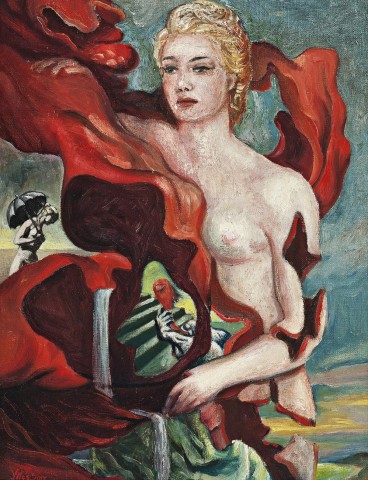SALVAGE FROM RANDOM’S EFFIGY, 1939 – 41
JAMES GLEESON
oil on canvas on board
45.5 x 35.0 cm
signed lower left: J Gleeson.
signed and inscribed with title verso: “Salvage from random’s / effigy” / James Gleeson / Lamington Hall / 48 Margaret St / Sydney
bears inscription verso: To Hazel and Col / 1944
Macquarie Galleries, Sydney (labels attached verso)
Private collection, Queensland, acquired from the above 1983
The Estate of the above, Queensland
Contemporary Art Society 1942 Exhibition, Athenaeum Gallery, Melbourne, 4 – 15 August 1942, cat.29
Contemporary Art Society: Fourth annual exhibition, David Jones Art Gallery, Sydney, open 8 September 1942, cat. 40
When James Gleeson first exhibited Salvage from Random’s Effigy, 1939 – 41 the Second World War had been raging for almost three years, eventually reaching Australian shores with the terrifying bombing of Darwin and the submarine attack on Sydney Harbour in February, then May of 1942. Gleeson and a number of his artist-associates had been concerned by the insidious rise of Fascism for many years, and utilised their individualistic styles in an attempt to illustrate or articulate the horror that they felt. Gleeson, a deeply read man who also wrote poetry, found a suitable strategy in Surrealism which, through its probing and analysis of the subconscious, explored ‘the realms of imagination and politics’.1 Nearly eighty years after their creation, his paintings remain some of the most enigmatic and haunting images to have been produced in Australia during this traumatic period.
Gleeson was always the first to point out that he was a child of war, having been born within the shadow of the conflict of 1914 – 18. By the time he started his studies at the East Sydney Technical College, he had already absorbed many of surrealism’s ideas, and ‘trained himself in the habit of recording each dream, each nightmare too, that surfaced intelligibly from his subconscious’.2 Moving on to the Sydney Teachers’ College in 1937, Gleeson’s new lecturer May Marsden proved to be a supportive mentor who encouraged him ‘to pursue his interest in Surrealism as a painter rather than a poet. He found that with May Marsden, ’I was taught to free up my work and open up to my imagination’.3 His early paintings were so self-composed and accomplished in their vision that Marsden purchased City on a Tongue, 1938, for the College’s own collection.4 The genesis for many of his subsequent paintings, including Salvage From Random’s Effigy, can already be intuited from this work. Gleeson closely studied the humanity of classical figures and myth as painted by artists including El Greco, Poussin and Blake, but his new visions proudly bore the additional inspiration of contemporaries such as Freud, Dali, de Chirico and Masson. In Salvage from Random’s Effigy, the central female figure unfurls into the landscape as her red shroud, a visual metaphor for one’s unraveling consciousness, flows around her. Intriguingly, the strange biomorphic figure seen through one of her apertures – one eye closed as it struggles up some stairs – bears an uncanny resemblance to a similar ‘creature’ seen amidst a half-built structure in Filigree, 1939 (Deutscher and Hackett, 18 April 2018, lot 13). The waterfall is also a repeating motif, as Gleeson admitted to being fascinated by zones where water and land meet, which, for him, represented a ‘liminal’ border between the rational and the irrational.5
Salvage from Random’s Effigy was part of the Contemporary Art Society’s two annual exhibitions in 1942, both of which included a wide range of artists’ responses to the war. Gleeson’s other entries in these shows included: Coagulations on the Maintenance of Identity, subsequently reproduced in colour on the cover of Angry Penguins, no.4, 1942; Perseus (National Gallery of Australia, Canberra); and The Betrothal of Two Classical Edifices (Deutscher and Hackett, 26 November 2008, lot 1), all of which are enveloped in their own unsettling mystery.
1. Beilharz, P., Imagining the Antipodes: culture, theory and the visual in the work of Bernard Smith, Cambridge University Press, England, 1997, p. 5
2. James, B., Australian Surrealism: the Agapitos/Wilson Collection, The Beagle Press, Sydney, 2003, p. 65
3. James Gleeson, 1998, quoted in Chanin, E. and Miller, S., Degenerates and Perverts: the 1939 Herald exhibition of French and British contemporary art, The Miegunyah Press, Melbourne, 2005, p. 103
4. The Collection of the Sydney Teachers’ College now forms part of the University of Sydney Art Collection.
5. See Chapman, C., ‘Surrealism in Australia’, in Gott, T. and others, Surrealism by Night, National Gallery of Australia, Canberra, 1993, p. 305
ANDREW GAYNOR
